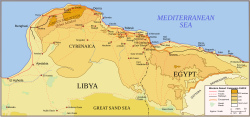The XX Army Corps was a corps of the Royal Italian Army during World War II. The XX Corps took part in the Western Desert Campaign from summer 1941 to 1943.
Between 10 September 1941 and 10 March 1942 the unit was named Maneuver Army Corps (Italian : Corpo d'Armata di Manovra). [1]
Contents
